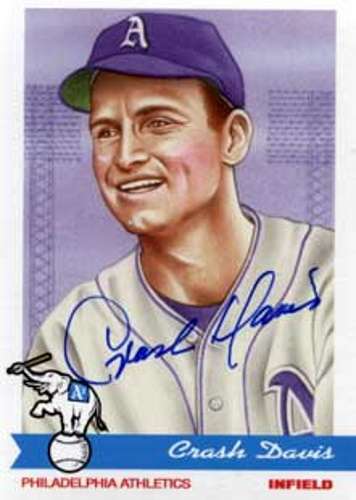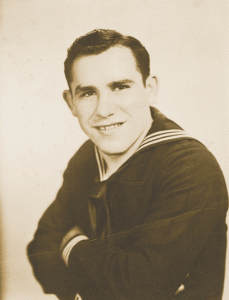Yogi Berra might never have starred for the New York Yankees had he not talked his way onto the Navy team based at the Groton submarine base in 1945.
He had to beg the manager to let him try out. He was a short, squat, awkward gunner’s mate who’d seen action on D-Day. Now, as World War II wound down, he’d returned to the States and longed to play baseball.
“If I didn’t make it in baseball, I won’t have made it workin’,” he said. “I didn’t like to work.”
Yogi Berra
The base’s ball club was run by James Gleeson, a former Major League outfielder nicknamed “Gee-Gee.” Gleeson didn’t think Berra looked anything like a ballplayer. “So I’m ugly,” Yogi later said. “I never saw anyone hit with his face.”
Gleeson didn’t believe Yogi was the property of the New York Yankees, either.

James “Gee-Gee” Gleeson
Yogi finally convinced him, and he went on to become a Hall of Famer and a beloved cultural figure. His unwittingly witty comments were known as Yogi-isms. “Nobody goes there anymore. It’s too crowded,” was one of his many classic lines. So was, “A nickel ain’t worth a dime anymore.”
Yogi tried to distance himself from his Yogi-isms. “I never said most of the things I said,” he said.
Lawrence Peter Berra
Berra was born Lawrence Peter Berra on May 12, 1925 in St. Louis to a family of Italian immigrants. He dropped out of school after eighth grade because all he wanted to do was to play baseball.
“Little League baseball is a very good thing because it keeps the parents off the streets,” he said.
After his best friend Joe Garagiola signed with the St. Louis Cardinals for a $500 bonus, Yogi Berra decided he had to have a $500 bonus too. The Yankees gave him one, along with $90 a month to play for their Norfolk, Va., minor league team, the Tars.
As a Tar in 1943, Yogi Berra hit seven home runs and 56 RBIs – including 23 in one double header. At the end of the season Berra enlisted in the Navy. He became a gunner’s mate and saw action on D-Day aboard a rocket boat, a 36-foot landing craft that sprayed rockets on the beach before the troops landed. Berra spent 10 days on the boat before he finally returned to his ship.
About the invasion, he said, ‘we were closer than the hitter is to the Green Monster at Fenway Park.’ At 18, he didn’t think anything could kill him.
I didn’t know enough to be scared. I had my head up over the side of the boat all the time, looking around like it was the Fourth of July in Forest Park and after the fireworks we were going to go over and get some hot dog and cokes.
New England Baseball (Not the Red Sox)
Before he was mustered out, Yogi Berra was stationed at the submarine base at Groton, Conn., where he finally convinced James Gleeson to let him play.
New England was a good place to hone one’s baseball skills as World War II wound down. Thousands of young men who played baseball, some in the Major Leagues, were stationed at military installations throughout the region. They could play for service teams like the Groton Raiders. Or they could play for for teams in the New England League like the Nashua Dodgers and the Pawtucket Slaters. They could even play for both. The League didn’t allow players signed with professional teams to play semi-pro games as ringers, and the military discouraged the practice. But on the semipro teams they could make $50 a game – half a month’s pay. So the professionals played under assumed names on their days off.

As a Yankee in 1953
Yogi Berra played under an assumed name for the Cranston Chiefs (later the Providence Grays) of the New England League.
His record is murky, as local sportswriters protected the identity of the players. “The New England is a league of aliases and fictitious names. No scribe desires to prevent any young man from earning a dollar by using his right name,” the Lynn Evening Item wrote.
Cusano?
The Italian-American Writer blog shared a memory of Yogi Berra as a Chiefs player:
At Cranston Stadium, for example, a guy named Cusano kept hitting home runs for the Cranston Chiefs and few people knew that his real name was Yogi Berra, a top Yankee prospect.
The city updated the field and raised the fence 30 ft because one day Berra… uhhh Cusano… hit a ball 500 feet off the roof of the Cranston Bible Chapel in centerfield.

The real Crash Davis (Kevin Costner played the fictional Crash Davis in Bull Durham)
Crash Davis had played professional ball for the Philadelphia Athletics before being drafted by the Navy. As the war wound down, he managed the Lawrence Millionaires of the New England League.
I remember one game when we were playing in Providence, Rhode Island, and all those players were using assumed names. Jimmy Gleeson, who had been with the Cubs and the Reds, was playing in the league and first base was open so I elected to walk him. I didn’t know that little guy that was hitting next but I knew Gleeson. That short little guy looked about 18 or 19 years old, and it turned out he hit a home run with the bases loaded. His real name was Lawrence ‘Yogi’ Berra.
The Legend of Yogi Berra
On June 25, 1945, the Yogi Berra legend was born. The New York Giants, returning from a series with the Boston Braves, played against the Groton team. Berra went 3-for-4. One of his hits came off a wild pitch. Giants manager Mel Ott decided he had to have the odd little catcher. He offered the Yankees $50,000 for Berra. Yankees general manager Larry MacPhail refused without knowing who Yogi Berra was – but decided to find out.
MacPhail summoned Berra to New York for an interview. Yogi walked in wearing the sailor’s outfit so unflattering to his short, squat physique. “You want to see me, Mister?” he said to MacPhail. MacPhail was stunned. He later recollected that Yogi ‘looked like the bottom man on an unemployed acrobatic team.’
But Yogi managed to convince MacPhail he was a professional ball player — by asking who he should see about his expenses for the trip.
MacPhail promoted him to the Newark Bears, just one rung down from the New York Yankees, for the 1946 season.
The Yankees
On Sept. 22, 1946, Yogi Berra was called up to the Yankees. As a Yankee he would appear in 14 World Series and on 18 All Star teams, and he would win the American League’s Most Valuable Player honor three times. In 1972, he was elected to baseball’s Hall of Fame.
On a night the Yankees chose to honor him, he expressed his appreciation: “I’m a lucky guy and I’m happy to be with the Yankees. And I want to thank everyone for making this night necessary.”
James Gleeson in 1964 became Yankees’ manager Yogi Berra’s first base coach.
Yogi Berra died on Sept. 22, 2015, at the age of 90. His advice to mourners: “You should always go to other people’s funerals, otherwise, they won’t come to yours.”
With thanks to The New England League: A Baseball History, 1885-1949 By Charlie Bevis and Yogi Berra: Eternal Yankee By Allen Barra. This story was updated in 2022.
Images: Newark Bears By buba69 – https://www.flickr.com/photos/buba69/1297630664/sizes/o/, CC BY 2.0, https://commons.wikimedia.org/w/index.php?curid=31323851.



2 comments
[…] On D-Day he was a 51-year-old brigadier general, assistant commander of the 29th division. He was also one of the highest ranking officers on Omaha Beach that day and possibly the oldest person. […]
[…] https://newenglandhistoricalsociety.com/yogi-berra-hits-his-way-through-new-england-sometimes-und… […]
Comments are closed.